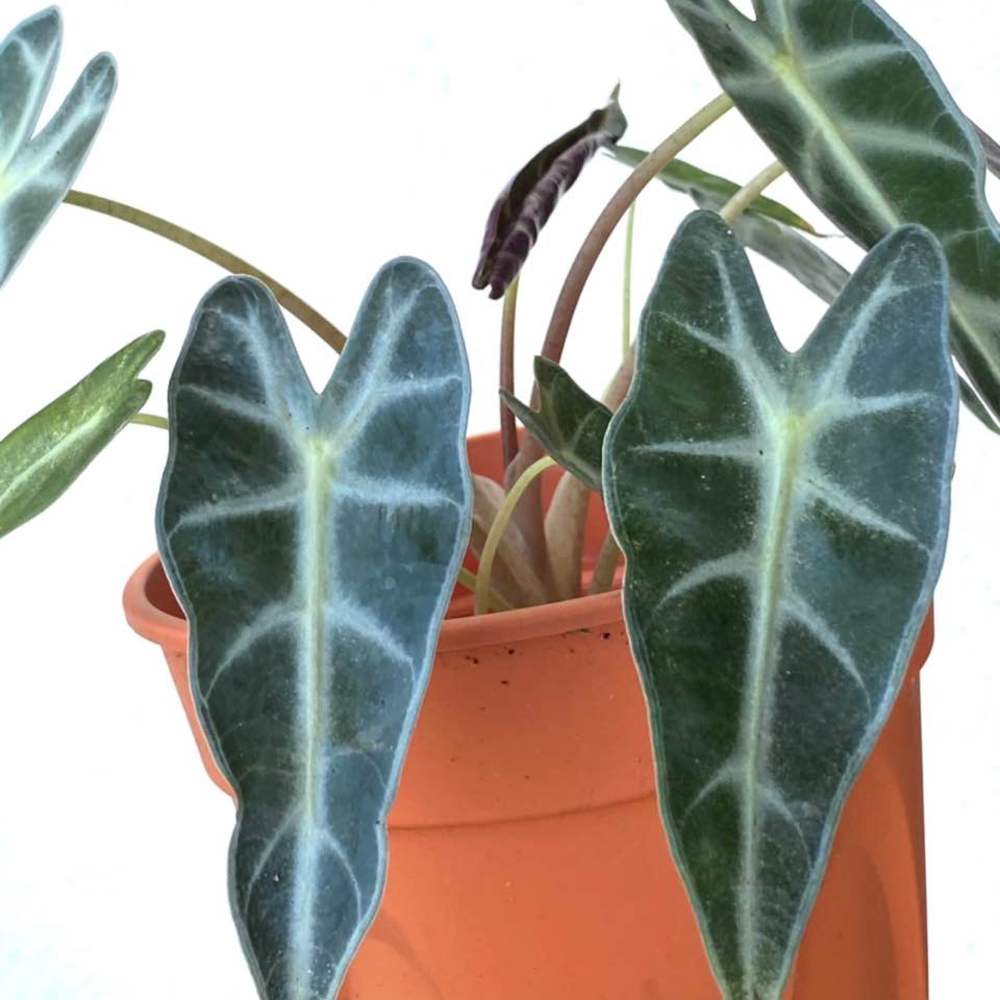植物经验
详细说明
LIGHT
An Alocasia plant requires very bright indirect light but no direct sun.
WATER
Allow the top 2"- 3" of soil to dry out before watering. Try to keep the soil evenly moist. Over-watering, wet leaves, and soggy soil makes an alocasia plant susceptible to a variety of serious fungal infections. Check the soil frequently until you are sure of the plant's watering needs. Alocasia plants require less water during the winter when it's dormant.
FERTILIZER
Fertilize every two weeks from late March through September with a basic houseplant food diluted to 1/2 the recommended strength. Never fertilize during the winter. Too much plant food results in salts building up in the soil and burning the leaves.
TEMPERATURE
Alocasia plants prefer warm temperatures between 60°-80°F (15.6°-26.7°C). These plants become dormant with prolonged exposure to temperatures below 60°F (15.6°C) and may drop all of their leaves. Be sure to keep an Alocasia plant away from air conditioners and cold drafts. During warm summer months, an Alocasia can produce a new leaf every week and each new leaf may be twice the size of the previous leaf.
HUMIDITY
Alocasia plants grow best in high humidity. To increase the humidity, place the plant on a tray filled with pebbles and water. Be sure the plant is sitting on the pebbles and not in the water. You can also increase the humidity by placing a small humidifier near the plant or grouping plants together. Do not mist the plant; misting encourages plant diseases.
FLOWERING
The flowers of an alocasia plant are very small and inconsequential in comparison to the beautiful leaves.
PESTS
Spraying an alocasia with warm soapy water every few weeks helps prevent Mealy Bugs, scale, Aphids, and spider mite problems. It also keeps the large leaves of the plant dust-free. If an Alocasia does become infested, spray with an ultra fine commercial insecticidal oil or Neem Oil. This kills both the pests and their eggs.
DISEASES
When alocasia plants are over-watered or when the leaves are consistently wet, they develop a variety of diseases such as crown, stem, and root rot, leaf spot, and xanthamonas. These diseases usually appear as dark brown or black spots on the leaves, surrounded by a yellowish rim. The best way to prevent plant diseases is to avoid over-watering, keep the leaves dry, and provide good air circulation around the plant. Once an alocasia is infected, quickly remove the damaged leaves and any leaves that have fallen off, isolate the plant from your other plants, and treat with a commercial Fungicide.
SOIL
Use an organic well-aerated loose soil that contains a good amount of peat moss. If the soil seems a little heavy, add some builder's sand or perlite.
POT SIZE
Alocasias plants like to be root-bound in small pots, so don't rush to put them into larger pots.
PRUNING
Quickly remove any yellow leaves or those that develop brown or black spots as that may be a sign of a fungal disease.
PROPAGATION
plant division is the best way to propagate.
RESTING PERIOD
An alocasia becomes dormant for several months during the late fall and winter.
POISONOUS PLANT INFO
This is a very poisonous plant with a #4 toxicity level. Kept an alocasia plant far away from small children and pets.
An Alocasia plant requires very bright indirect light but no direct sun.
WATER
Allow the top 2"- 3" of soil to dry out before watering. Try to keep the soil evenly moist. Over-watering, wet leaves, and soggy soil makes an alocasia plant susceptible to a variety of serious fungal infections. Check the soil frequently until you are sure of the plant's watering needs. Alocasia plants require less water during the winter when it's dormant.
FERTILIZER
Fertilize every two weeks from late March through September with a basic houseplant food diluted to 1/2 the recommended strength. Never fertilize during the winter. Too much plant food results in salts building up in the soil and burning the leaves.
TEMPERATURE
Alocasia plants prefer warm temperatures between 60°-80°F (15.6°-26.7°C). These plants become dormant with prolonged exposure to temperatures below 60°F (15.6°C) and may drop all of their leaves. Be sure to keep an Alocasia plant away from air conditioners and cold drafts. During warm summer months, an Alocasia can produce a new leaf every week and each new leaf may be twice the size of the previous leaf.
HUMIDITY
Alocasia plants grow best in high humidity. To increase the humidity, place the plant on a tray filled with pebbles and water. Be sure the plant is sitting on the pebbles and not in the water. You can also increase the humidity by placing a small humidifier near the plant or grouping plants together. Do not mist the plant; misting encourages plant diseases.
FLOWERING
The flowers of an alocasia plant are very small and inconsequential in comparison to the beautiful leaves.
PESTS
Spraying an alocasia with warm soapy water every few weeks helps prevent Mealy Bugs, scale, Aphids, and spider mite problems. It also keeps the large leaves of the plant dust-free. If an Alocasia does become infested, spray with an ultra fine commercial insecticidal oil or Neem Oil. This kills both the pests and their eggs.
DISEASES
When alocasia plants are over-watered or when the leaves are consistently wet, they develop a variety of diseases such as crown, stem, and root rot, leaf spot, and xanthamonas. These diseases usually appear as dark brown or black spots on the leaves, surrounded by a yellowish rim. The best way to prevent plant diseases is to avoid over-watering, keep the leaves dry, and provide good air circulation around the plant. Once an alocasia is infected, quickly remove the damaged leaves and any leaves that have fallen off, isolate the plant from your other plants, and treat with a commercial Fungicide.
SOIL
Use an organic well-aerated loose soil that contains a good amount of peat moss. If the soil seems a little heavy, add some builder's sand or perlite.
POT SIZE
Alocasias plants like to be root-bound in small pots, so don't rush to put them into larger pots.
PRUNING
Quickly remove any yellow leaves or those that develop brown or black spots as that may be a sign of a fungal disease.
PROPAGATION
plant division is the best way to propagate.
RESTING PERIOD
An alocasia becomes dormant for several months during the late fall and winter.
POISONOUS PLANT INFO
This is a very poisonous plant with a #4 toxicity level. Kept an alocasia plant far away from small children and pets.
花相册 (1)

kensong
2020年12月22日

This is my first growing diary. Gift from Mona.







